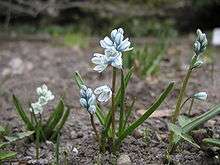Puschkinia
Puschkinia is a genus of three known species of bulbous perennials in the family Asparagaceae, subfamily Scilloideae.[2] It is native to the Caucasus and the Middle East.[1] Puschkinia scilloides is grown as an ornamental bulbous plant.
| Puschkinia | |
|---|---|
 | |
| Puschkinia scilloides | |
| Scientific classification | |
| Kingdom: | Plantae |
| Clade: | Tracheophytes |
| Clade: | Angiosperms |
| Clade: | Monocots |
| Order: | Asparagales |
| Family: | Asparagaceae |
| Subfamily: | Scilloideae |
| Genus: | Puschkinia Adams[1] |
| Synonyms[1] | |
|
Adamsia Willd. | |
Description
The leaves are green, strap-like, and grow in pairs. The flowers are borne in early spring in racemes up to about 25 cm (10 in) high. The six tepals are joined at the base to form a tube to about half their length. Like members of the genus Chionodoxa, the bases of the stamens are flattened and closely clustered in the middle of the flower; however, unlike Chionodoxa, they are joined to form a cup or corona. In the related genus Scilla (squills), the stamens are not flattened or clustered together. Seeds are borne in three-parted capsules. After the seed ripens in early summer, the plants become dormant until the next spring.[3][4]

Taxonomy
The genus Puschkinia was erected by Johann Friedrich Adam in 1805.[1] It is named in honor of the Russian botanist Apollo Mussin-Pushkin.[4] Now placed in the subfamily Scilloideae of the family Asparagaceae,[2] like other lilioid monocots, it was once included in the Liliaceae.
Species
As of May 2017, the World Checklist of Selected Plant Families accepted three species:[5]
- Puschkinia bilgineri Yildirim – Turkey
- Puschkinia peshmenii Rix & B.Mathew - native to Turkey and Iran
- Puschkinia scilloides Adams (striped squill) - native to the Caucasus, Turkey, northern Iran and Lebanon; found in mountain meadows and stony slopes up to 3,000 m (9,800 ft)
Cultivation
Puschkinia scilloides is grown as an ornamental bulbous plant, particularly recommended as an early flowering bulb for cool, well drained positions.[3] Puschkinia peshmenii is rare in cultivation.[4]
Culture
In 1993, an illustration of Puschkinia scilloides was used as a postage stamp in Azerbaijan, with a series of other flowers, including Iris reticulata, Tulipa systola (syn. T. persica), Iris acutiloba, Iris iberica subsp. elegantissima (syn. I. elegantissima) and Tulipa florenskyii.[6]
References
- "Puschkinia", World Checklist of Selected Plant Families, Royal Botanic Gardens, Kew, retrieved 2017-08-08
- Stevens, P.F., Angiosperm Phylogeny Website: Asparagales: Scilloideae, retrieved 2017-08-08
- Mathew, Brian (1987), "Puschkinia", The Smaller Bulbs, London: B.T. Batsford, p. 145, ISBN 978-0-7134-4922-8
- Rix, Martyn & Mathew, Brian (2007), "582. Puschkinia peshmenii", Curtis's Botanical Magazine, 24 (1): 54–57, doi:10.1111/j.1467-8748.2007.00561.x
- "Search for Puschkinia", World Checklist of Selected Plant Families, Royal Botanic Gardens, Kew, retrieved 2017-05-05
- "Azerbaijan". stampworld.com. Retrieved 7 March 2016.
External links
| Wikimedia Commons has media related to Puschkinia. |